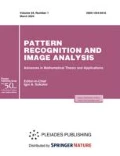Abstract
The paper presents a study of new representations of images based on special metadata related to the optimal partitioning of sampled random (photo) counts. The use of partitions based on the lattice model of image provides the proposed representations property of scalability. Since the control of the scale is connected only with the choice of the lattice parameters, the question of the balance of dimension/precision characteristics turns out to be an easily controllable factor in the procedure for representations formation. The flexibility of representations in relation to these characteristics implies their widespread application in a whole range of tasks related to the big data problem: image classification, object identification, characteristic features extraction, etc. From a mathematical point of view, a main feature of the proposed approach is the specificity of the statistical description of initial image data, random counts. This description is in good agreement with the formalism of naive Bayesian and other approaches in the field of machine learning. In particular, by analogy with the well-known K-mean segmentation method, it is possible to synthesize a recurrent procedure for partitioning–maximization of sampled counts in order to find the maximal plausible parameters of the metadata of the representations. A new element here is the introduction of the concept of a lattice environment of counts, which makes it possible to effectively control the amount of computations. The relationship of the lattice environment with the concept that is widely used today in the field of convolutional neural networks (CNNs), the concept of receptive fields, is discussed. The paper discusses in detail the algorithmic implementation of the procedure obtained and provides a detailed discussion of a number of its features, including questions of convergence, asymptotic efficiency, etc. All questions of applying the procedure to the formation of representations of real images are illustrated by computer simulations.





Similar content being viewed by others
REFERENCES
V. E. Antsiperov, “New machine learning based method for identifying objects in biomedical images obtained by photon counting detectors,” Zh. Radioelektron., No. 11 (2020). https://doi.org/10.30898/1684-1719.2020.11.14
V. Antsiperov, “New maximum similarity method for object identification in photon counting imaging,” in Proceedings of the 10th International Conference on Pattern Recognition Applications and Methods (2021), Vol. 1, pp. 341–348. https://doi.org/10.5220/0010346803410348
V. Antsiperov, “Maximum similarity method for image mining,” in Proceedings of the Pattern Recognition ICPR International Workshops and Challenges, Part V (Springer, 2021), pp. 301–313. https://doi.org/10.1007/978-3-030-68821-9_28
V. E. Antsiperov, “Target identification for photon-counting image sensors, inspired by mechanisms of human visual perception,” J. Phys.: Conf. Ser. 1368, 032020 (2019). https://doi.org/10.1088/1742-6596/1368/3/032020
K. P. Burnham and D. R. Anderson, Model Selection and Inference: A Practical Information-Theoretic Approach (Springer-Verlag, New York, 1998). https://doi.org/10.1007/978-1-4757-2917-7
T. M. Cover and J. A. Thomas, Elements of Information Theory, 2nd ed. (John Wiley & Sons, Inc., Hoboken, NJ, 2006). https://doi.org/10.1002/047174882X
E. R. Fossum et al. “The quanta image sensor: Every photon counts,” Sensors 16 (8), 1260 (2016). https://doi.org/10.3390/s16081260
R. H. Hariri, E. M. Fredericks, and K. M. Bowers, “Uncertainty in big data analytics: Survey, opportunities, and challenges,” J. Big Data 6 (1), 1–16 (2019). https://doi.org/10.1186/s40537-019-0206-3
D. H. Hubel and T. N. Wiesel, Brain and Visual Perception: The Story of a 25-Year Collaboration (Oxford Univ. Press, New York, 2004). https://doi.org/10.1093/acprof:oso/9780195176186.001.0001
J. Hutchison, “Culture, communication, and an information age Madonna,” IEEE Prof. Commun. Soc. Newsl. 45 (3), 1–7 (2001).
B. Jähne, Digital Image Processing, 6th ed. (Springer-Verlag, Berlin, 2005). https://doi.org/10.1007/3-540-27563-0
R. Kitchin, The Data Revolution: Big Data, Open Data, Data Infrastructures and Their Consequences (Sage Publ. Ltd., 2014). https://doi.org/10.4135/9781473909472
V. Mehta, M. Bukov, et al., “A high-bias, low-variance introduction to Machine Learning for physicists,” Phys. Rep. 810, 1–124 (2019). https://doi.org/10.1016/j.physrep.2019.03.001
N. R. Pal and S. K. Pal, “Image model, Poisson distribution and object extraction,” J. Pattern Recognit. Artif. Intell. 5 (3), 459–483 (1991). https://doi.org/10.1142/S0218001491000260
D. Pile, “Megapixel single-photon camera,” Nat. Photonics 14 (10), 597–597 (2020). https://doi.org/10.1038/s41566-020-0697-7
C. P. Robert and G. Casella, Monte Carlo Statistical Methods, 2nd ed. (Springer-Verlag, New York, 2004). https://doi.org/10.1007/978-1-4757-4145-2
Funding
This study was financially supported by the Russian Foundation for Basic Research (RFBR), project no. 18-07-01295 A.
Author information
Authors and Affiliations
Corresponding author
Ethics declarations
COMPLIANCE WITH ETHICAL STANDARDS
This article is a completely original work by the author; it has not been previously published and will not be published in other publications.
CONFLICT OF INTEREST
The author states that he has no conflict of interest.
Additional information

Viacheslav Antsiperov. Born 1959. Graduated from Moscow Institute of Physics and Technology in 1982. Received Candidate’s degree (Physics and Mathematics) in 1986. Leading Researcher at the Kotelnikov Institute of Radio Engineering and Electronics of the Russian Academy of Sciences. Scientific interests: information systems, processing and analysis of signals, including image and speech recognition, and biomedical informatics. Author of more than 100 papers.
Rights and permissions
About this article
Cite this article
Antsiperov, V.E. Representation of Images by the Optimal Lattice Partitions of Random Counts. Pattern Recognit. Image Anal. 31, 381–393 (2021). https://doi.org/10.1134/S1054661821030044
Received:
Revised:
Accepted:
Published:
Issue Date:
DOI: https://doi.org/10.1134/S1054661821030044




